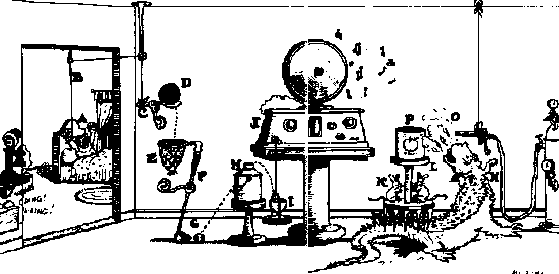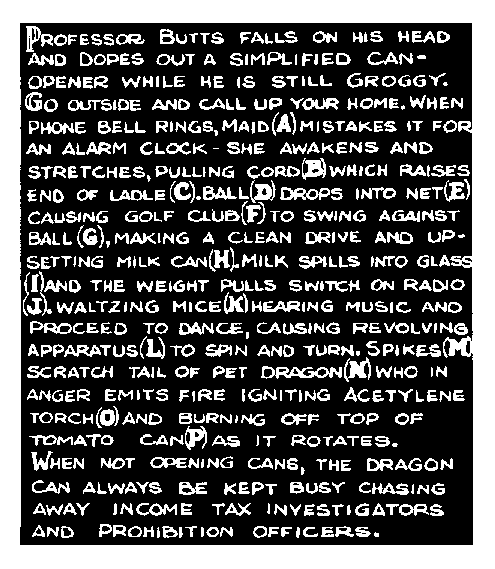Gears:
Technology, Literature,
Culture in Modernist America
Cecelia Tichi
(University of North Carolina Press)

-
That world was remarkable for visual accessibility. To scan photographs of the machines and structures between the 1890s and the 1920s is to be visually involved. An onlooker has immediate access to the construction, to the design decisions of the engineers and architects. Open to view, so obviously designed, the world of girders and gears invites the onlooker to see its internal workings, its component parts.
 Tichi succeeds in drawing us in, and convincing us of her theory --- with both the text and a fine selection of photographs, drawings, and advertisements of the era. And her utilization of the writers of the time is appropriate, and astute, such as this familiar verse from William Carlos Williams:
Tichi succeeds in drawing us in, and convincing us of her theory --- with both the text and a fine selection of photographs, drawings, and advertisements of the era. And her utilization of the writers of the time is appropriate, and astute, such as this familiar verse from William Carlos Williams:
so much depends
upon
a red wheel
barrow
glazed with rain
water
beside the white
chickens.
Sam Hall Kaplan
(Crown)
When the poet William Butler Yeats came to Los Angeles in 1925, he is reported to have said
- here, if anywhere else in America, I seem to hear the coming footsteps of the muse.
If more prescient, he would have heard the area's muse schlepping by on Firestone radials. Kaplan was design critic for the Los Angeles Times and he tries here to give us a brief narrative history, with drawings and photographs, of the city.
Like the city, though, this work has a slapdash feeling, as if Kaplan could barely squeeze time for it between the many articles he writes for Harpers, the New York Times, the Village Voice, and his own newspaper. Further, the book itself is designed with a sense of aesthetics not too distant from the Pasadena freeway or the Home Savings building --- there seems to be no there there. The text and the aesthetic of the book thin out towards the end, as we get closer to our own time, because Los Angeles has been, for so long, deflowered, mugged, stuck-up, raped, run over and squashed by the conglomerate architects, the tax laws, and the megabusinesses who have yet to learn the price of their forty- or sixty-story glassy-eyed behemoths. The downtown, once a collection of the garish, funny, and Victorian, has come to have all the warmth of downtown Atlanta, Houston, or Akron.
L. A. Lost & Found does have its moments: early photographs of Venice, the heartbreaking shots of old Pacific Electric interurban system (the best in the world, now dismantled), or a rollicking old song "In the Land of the Bungalow:"
-
I just got off the Sunset Train,
I'm from the Angel Town,
The Golden West Los Angeles,
Where the sun shines all year 'round.
I left a girlie back there,
She's the sweetest girl I know,
She said "good-bye," I'll wait for you,
In the land of the bungalow.
Daniel Halpern
(Viking Penguin)
Halpern is one of those six-published-books, fifty-two-year-old, been-
And yet you suspect, and you suspect strongly, that even with the love and support of the North American Marshmallow and Pudding Poets' Society, complete with credits from The New Yorker,The New Republic, The Paris Review, The Missouri Review --- despite all that, you have the feeling that this feller Halpern is going to rise out of the sea like a great barnacled whale, blow some spume about for a frozen moment or two (woosh!) and then just disappear --- with a flip of the tail --- into the depths, never to be heard of again, ever.
Tango has a strong, if not rank, smell of ephemera, especially with lines like this, so sparse and innocent of the rich rhythms of the English language:
-
Placing my hand
over the words of my descriptive prose
set out in obsessive syllables,
I looked over at him.
It was Gaudier-Brezeska's portrait of Pound
that prefaces Personæ
with the eyes colored in,
steady and there.
Try to read, just you try to intone, in earth-easy style, "it was Gaudier-
of Glass Paperweights
Paul Hollister, Jr.
(Paperweight Press)
We know, we know --- given the famines in Africa, the murders in Bosnia, and Pat Robertson railing about the things we are doing with our privates --- why should we be concerned about glass paperweights? Well, why not? For one thing, the Clichy spaced millefiori on opaque white ground, canes sunk in pockets is quite handsome, and can be used for something: that is, not only keeping your desk papers from blowing around but threatening the cat and looking at, in a daze, when you can't think of anything else to do.
Some paperweights are round, some squat, some are oval, some handsomely cut, and one, the Kaziun apricot-colored double overlay with deep red rose is funny looking enough to make us want to get into the paperweight business. According to Hollister, the first millefiori was created in Bohemia-Silesia in 1845; he is only interested in the "classic" ones which were made between then and 1870. He tells us that some "50,000 of good quality were made...[and] probably not more than a third to a half survive..."
He says that the paperweight is "all glass and art," suggests that there are many secrets of manufacturing not yet revealed, and lists Oscar Wilde, Carlotta, wife of Emperor Maximilian of Mexico, and King Farouk as collectors.
-
The mystery of the interior glass design is further complicated and enhanced by the continuity of a single refractive index, which renders every element of the glass design without that surface reflection or shine we tend to associate with glass. We are gazing into a mystery whose true dimensions and physical composition our senses are unable to pinpoint, a mystery sealed away in perpetuity...
and Desert Eyes
A Life and a Story
David Thomson
(Doubleday)
They tell us that David Thomson is a critic of no little reknown. Two decades ago he created A Biographical Dictionary of Film which was described in the "New York Times Book Review" as "addictive." More recently, he has produced several books and more than a hundred articles on cinema, and is the lead film critic for Esquire. He shares with Pauline Kael an obsessive fascination with the history, focus, style, and form of film. (He also shares with Ms. Kael a certain run-on, breathless, second person singular style of writing which is rather overwhelming, if not literate).
For that reason, this study of one of our more flamboyant and eccentric actors is to be welcomed. Thomson apparently knows all there is to know about Beatty's works. For example, he gives us rich insight into an obscure film by the name of Lilith. "It is one of the best things Warren Beatty will ever do," he writes. "Perhaps it is great acting; perhaps the final giving of self." His perceptions are such that we want to go out and rent the damn thing just to see it through his eyes, which is all we can ask of a critic.
Unfortunately, in Warren Beatty and Desert Eyes, the author has chosen to create a rather peculiar mix of fiction and criticism. The odd chapters consist of analysis of Beatty's films, complete with appropriate clips of his life and his loves. The even chapters are given over to a neo-Huxlian, quasi-Orwellian science-fiction fantasy about Los Angeles sometime in the future. The smog has turned the city and its people grey and tasteless; the entertainment industry is shown to be so sordid as to make Washington D. C. Sex Pots into cherubim by comparison --- and when disaster strikes, in the form of a huge earthquake (created, apparently, by a scriptwriter) the survivors depart fully armed for Death Valley to eat baked salmon and truffles and ravish the lady refugees.
Beatty's real persona --- whatever the hell that might be --- turns Desert Eyes (and possibly Thomson himself) a mite schizophrenic. Throughout the non-fiction portions of the work he demonstrates a bothersome longing, addressing Beatty directly, begging him to pul-leese pay attention to him. "I really think I'd prefer you not calling, Warren," he writes, in a snit:
-
I did ask you once to talk...but you left me waiting for an answer, and so now, years later, you may reproach me for getting on and doing it without you; and you may wonder out loud in your lovely injured innocence how anyone could do such a book without knowing you.
Without overstating it, this strikes us as being uncomfortably close to verbal stalking, and we suspect most readers aren't all that keen to know about Thomson strange vision of the actor's "lovely injured innocence..."
Snubbed by a superstar who declined to play any part in this auteur's book of film, Thomson uses his writing to expiate his own injured innocence. He thus becomes a wordy, modern-day Boswell, mooning about, waiting for the call from his absent Johnson.